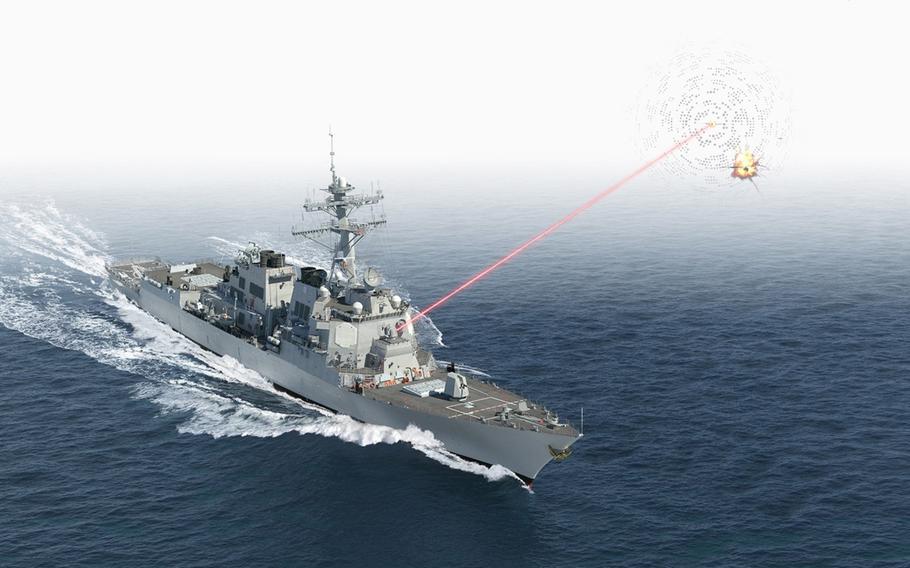
This photo illustration shows the guided-missile destroyer USS Preble, the only U.S. Navy warship equipped with a HELIOS weapons platform. (Lockheed Martin)
YOKOSUKA NAVAL BASE, Japan — The U.S. Navy’s only guided-missile destroyer equipped with a directed energy weapon is on its way to join the U.S. 7th Fleet in Japan.
The USS Preble left its former homeport of San Diego on Sept. 22 bound for Yokosuka, where it will take the place of the USS Benfold. That warship, meanwhile, will relocate to Everett, Wash., U.S. Pacific Fleet announced Thursday.
The Preble is the only U.S. warship outfitted with the High-Energy Laser with Integrated Optical-dazzler and Surveillance, or HELIOS, system. It can counter small watercraft or drones and is able to collect long-range intelligence, according to manufacturer Lockheed Martin’s website.
HELIOS remains in the at-sea testing phase and will continue testing while homeported in Yokosuka, Task Force 70 spokesman Lt. Cmdr. Seth Koenig told Stars and Stripes by email Tuesday.
“Deploying the most capable surface ships, such as USS Preble, and superior technology forward ensures the United States is best able to honor our security commitments to Japan and support a free and open Indo-Pacific,” he wrote.
The Benfold departs a year short of the Navy’s decade limit on overseas deployments for warships. It arrived in October 2015 as one of the most advanced destroyers in the service.
Koenig declined to comment on when the Benfold will depart or when the Preble will arrive, citing security concerns.
Ship swaps are relatively routine for the Navy, and the service over the past decade has regularly reassigned its most advanced vessels to the Indo-Pacific, which the Pentagon continues to view as an important theater due to actions by China, North Korea and Russia.
“It has been more than four years since Preble last operated in 7th Fleet,” the ship’s skipper, Cmdr. Paul Archer, said in the news release. “But Preble today is markedly different than the ship that last left 7th Fleet. Armed with the U.S. Navy’s most capable combat system suite, this crew is well-trained and hungry to take our cutting-edge warship west to support national strategic objectives.”
HELIOS works with the Preble’s Flight IIA Aegis Combat System — the Navy’s command-and-control suite aboard guided-missile destroyers — and uses the ship’s power rather than traditional ammunition, according to Lockheed Martin
“HELIOS enhances the overall combat system effectiveness of the ship to deter future threats and provide additional protection for Sailors, and we understand we must provide scalable solutions customized to the Navy’s priorities,” Rick Cordaro, vice president of Lockheed Martin Advanced Product Solutions, said in an Aug. 18 news release.
Lockheed Martin in March 2018 received a $150 million contract with options up to $942.8 million to develop, manufacture and deliver two HELIOS suites to the Navy.
Systems such as HELIOS offer significant strategic advantages, including a low cost per shot, faster and more precise targeting, the ability to counter “radically maneuvering missiles,” and the ability to graduate from detection and interference to disabling damage, according to an Aug. 26 report on shipboard lasers from the Congressional Research Service
Challenges, however, include line of sight limitations, atmospheric and weather interference, hardened targets and the potential for collateral damage, including damage to human eyesight, according to the report.